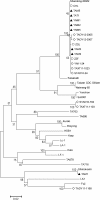Molecular epidemiology of Orientia tsutsugamushi in chiggers and ticks from domestic rodents in Shandong, northern China
- PMID: 24499627
- PMCID: PMC3843596
- DOI: 10.1186/1756-3305-6-312
Molecular epidemiology of Orientia tsutsugamushi in chiggers and ticks from domestic rodents in Shandong, northern China
Abstract
Background: Scrub typhus is endemic to a 13,000,000-km² area of the Asia-Pacific region, and causes an annual incidence of 1 million people. The mortality rate of scrub typhus ranges from 6.1% to 25% in Southeast Asia. Natural infection of Orientia tsutsugamushi has been identified in domestic rodents in Shandong Province. However, infestation of chiggers and ticks on the domestic rodents and prevalence and genotypes of O. tsutsugamushi in these Acarina remain unclear.
Methods: During September 2010 to March 2012, 3134 chiggers and 89 ticks were collected from domestic rodents captured in three counties of Shandong Province. We amplified and sequenced the 56-kDa type-specific antigen gene of O. tsutsugamushi from DNA samples of these Acarina and designated to genotype according to sequence analysis.
Results: Overall, the infestation rate of chiggers on domestic rodents was 17.0%, and the chigger index was 5.38. The infestation rate of ticks on rodents was 3.1%. Natural infection of O. tsutsugamushi was found in Leptotrombidium taishanicum, L. linhuaikongense, L. intermedium, L. scutellare, L. palpale, and Ixodes spp., the minimum positive rates of which were 5.9%, 3.2%, 1.2%, 0.8%, 0.8%, and 2.2%, respectively. Kawasaki-like genotypes were predominant in chiggers and ticks on domestic rodents, which were detected from L. taishanicum, L. intermedium, L. scutellare, L. palpale, and Ixodes spp. Shimokoshi-like genotype was detected from L. palpale.
Conclusions: In the present study we investigated the infestation of chiggers and ticks on domestic rodents in Shandong Province, and identified the prevalence and genotypes of O. tsutsugamushi in the Acarina. Infestation of vector chiggers in domestic rodents, prevalence of O. tsutsugamushi in infested chiggers, and high nucleotide homologies among the O. tsutsugamushi sequences from the Acarina, their animal hosts and scrub typhus patients, implied that domestic rodents may play an important role in the transmission of scrub typhus in Shandong, China. Further studies are needed to verify the vector significance of chiggers and ticks that tested positive for O. tsutsugamushi, and to assess the risk of human exposure to chiggers and ticks on domestic rodents.
Figures


References
-
- Oaks SCJ, Ridway RL, Shirai A, Twartz JC. Scrub typhus. Inst Med Res Malays Bull. 1983;21:1–98.
-
- Lee CS, Hwang JH, Lee HB, Kwon KS. Risk factors leading to fatal outcome in scrub typhus patients. Am J Trop Med Hyg. 2009;81(3):484–488. - PubMed
-
- Wang CC, Liu SF, Liu JW, Chung YH, Su MC, Lin MC. Acute respiratory distress syndrome in scrub typhus. Am J Trop Med Hyg. 2007;76(6):1148–1152. - PubMed
-
- Kelly DJ, Fuerst PA, Ching WM, Richards AL. Scrub typhus: the geographic distribution of phenotypic and genotypic variants of Orientia tsutsugamushi. Clin Infect Dis. 2009;48(Suppl 3):S203–S230. - PubMed
Publication types
MeSH terms
Substances
Associated data
- Actions
- Actions
- Actions
- Actions
- Actions
- Actions
- Actions
- Actions
LinkOut - more resources
Full Text Sources
Other Literature Sources
Miscellaneous

